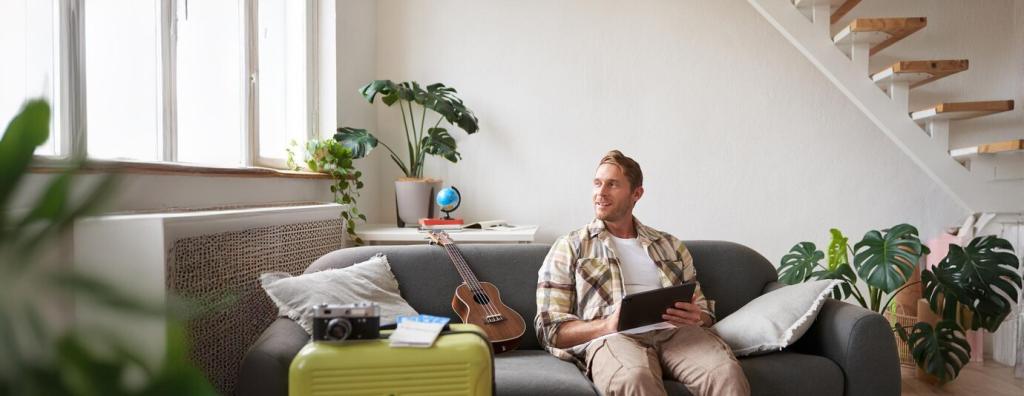Eco-Friendly Home Renovation Ideas
Eco-friendly home renovation is about transforming your living space into one that honors the planet while enhancing your comfort and saving money in the long run. By choosing sustainable materials, energy-efficient technologies, and mindful design strategies, homeowners can significantly reduce their environmental footprint. Whether you’re planning a complete remodel or simple upgrades, embracing green renovation techniques can create a lasting positive impact.

Sustainable Building Materials
Reclaimed wood is salvaged from old buildings, barns, or industrial sites and brings both charm and sustainability to home projects. Choosing reclaimed wood reduces the demand for newly harvested timber, curtailing deforestation and lowering your renovation’s carbon output. Its uniqueness and history can add unparalleled character to floors, walls, and furniture. Aside from environmental advantages, reclaimed wood is often more durable than newer alternatives, having matured and dried over many years. Opting for this material means less landfill waste and a strong statement about valuing existing resources.
Energy-Efficient Insulation
Cellulose insulation is primarily made from recycled newspaper and treated with natural fire retardants, offering outstanding environmental credentials. Its dense, fibrous nature forms effective barriers against heat loss and air leakage, making homes significantly more energy-efficient. Besides reducing energy bills, cellulose insulation supports the recycling industry by repurposing paper that may otherwise go to landfill. It is often blown into attics and walls, providing thorough coverage that rivals traditional fiberglass or foam.

Dual-Flush Toilets
Dual-flush toilets have become a hallmark of water conservation in residential settings. They offer two flushing options—one for liquid waste and a higher-volume flush for solids—allowing users to conserve water with every use. Some models can reduce household toilet water consumption by up to 70 percent each year. Modern designs integrate seamlessly into updated bathrooms, making this one of the simplest yet most effective upgrades you can include in your renovation.
Low-Flow Showerheads
Low-flow showerheads are designed to use significantly less water while maintaining satisfying water pressure. These devices incorporate advanced aerating or laminar flow technologies, ensuring an enjoyable shower experience with conservation in mind. Switching to a low-flow model can cut water usage for a family shower routine nearly in half, supporting both environmental health and cost savings. They are also straightforward to install, making them an accessible improvement for any green renovation.
Rainwater Harvesting Systems
Rainwater harvesting systems collect and store rainwater from your roof, making it available for outdoor irrigation, flushing toilets, or even washing clothes. This approach can dramatically reduce your reliance on municipal water supplies, especially in areas prone to drought. When properly installed, these systems are safe, low-maintenance, and customizable to any design. Incorporating rainwater harvesting in your renovation plan is an effective way to future-proof your home against water scarcity and rising utility costs.
Renewable Energy Solutions
Solar Panel Installations
Installing rooftop solar panels remains the most popular method for generating renewable electricity at home. These systems convert sunlight into usable power, offsetting your reliance on grid electricity and slashing utility bills. Many modern kits are sleek, efficient, and designed to blend into your home’s architecture. Over time, solar panels can make your home virtually energy-independent, reducing your carbon output and often increasing property value in the process.
Solar Water Heaters
Solar water heaters utilize energy from the sun to heat your household’s water supply. Unlike traditional electric or gas-fired units, solar heaters produce hot water with zero emissions and minimal operating costs, making them both eco-friendly and economical. They typically require only rooftops or sunny yards for installation and are effective across a range of climates. Choosing a solar water heater is a high-impact way to make your renovation greener while delivering reliable comfort for everyday living needs.
Home Battery Storage Systems
Home battery storage systems can store surplus solar or wind energy for use at night or during power outages. These systems maximize the efficiency of your renewable installations by ensuring that no clean energy goes to waste. Modern batteries are compact, reliable, and can integrate with smart home technologies to optimize energy usage. Including energy storage in your eco-friendly renovation plan promotes energy resilience and independence while supporting a clean, distributed power grid.
Smart Thermostats
Smart thermostats can learn your daily routines and adjust heating and cooling systems for optimal comfort and efficiency. Many models use sensors and Wi-Fi connectivity to provide real-time data and remote control via smartphones. By fine-tuning temperatures based on occupancy and weather, these devices reduce energy waste and lower costs. Incorporating a smart thermostat as part of your green renovation helps you maintain control over your home’s climate and maximize the benefits of any insulation or HVAC upgrades.
Automated Lighting Systems
Automated lighting systems allow you to schedule, dim, or turn off lights from anywhere, reducing energy usage without sacrificing illumination. These systems often include motion sensors that switch lights on only when needed, ensuring that rooms aren’t lit when unoccupied. With increasingly sophisticated bulb technology, automated lighting creates opportunities to personalize moods and colors while conserving electricity. Choosing this upgrade streamlines life and supports overall energy-saving goals.
Water Leak Detection Devices
Water leak detection devices can identify pipe bursts or hidden leaks the moment they occur, helping prevent water waste and safeguard your property from damage. These smart devices send instant alerts to your phone if unusual water activity is detected, allowing for rapid intervention. Installing leak sensors as part of your renovation is a proactive move—it protects your investment, prevents costly repairs, and ensures your home’s water usage remains sustainable for years to come.
HEPA air filtration systems are designed to remove particles as small as 0.3 microns from the air, including dust, pollen, mold spores, and pet dander. Installing a whole-home HEPA system or high-efficiency portable units in heavily used areas dramatically improves the air you breathe. These upgrades are especially important during and after renovations, when particulate matter tends to spike. By filtering out contaminants, you can reduce allergy symptoms and promote overall family health.
Indoor Air Quality Improvements
Deconstruction over Demolition
Deconstruction is the careful disassembly of existing structures, allowing valuable materials like wood, brick, and fixtures to be recovered for reuse or recycling. Unlike demolition, which sends most materials to the landfill, deconstruction preserves resources and often uncovers elements with unique history or character. This approach can require more time but results in less waste and frequently provides tax benefits when donating salvaged items. Committing to deconstruction makes your renovation process greener from the very start.
Donation and Reuse of Materials
Many renovation leftovers, such as cabinets, doors, windows, or hardware, are still usable and can easily find a second life with someone else. Numerous organizations and marketplaces accept and redistribute building materials and furniture, extending their usefulness and reducing demand for new items. Coordinating donations of surplus or gently used goods helps both the environment and the community, making your renovation effort doubly impactful.
On-Site Recycling Practices
Implementing on-site recycling practices ensures that materials like metal, glass, paper, and specific plastics are sorted properly and diverted away from landfill. Organizing dedicated bins and educating contractors and workers on recycling protocols supports this goal. Some construction waste, such as drywall or concrete, can even be processed into new building products. Making recycling a standard part of your renovation keeps your project organized and bolsters its sustainability credentials from start to finish.
